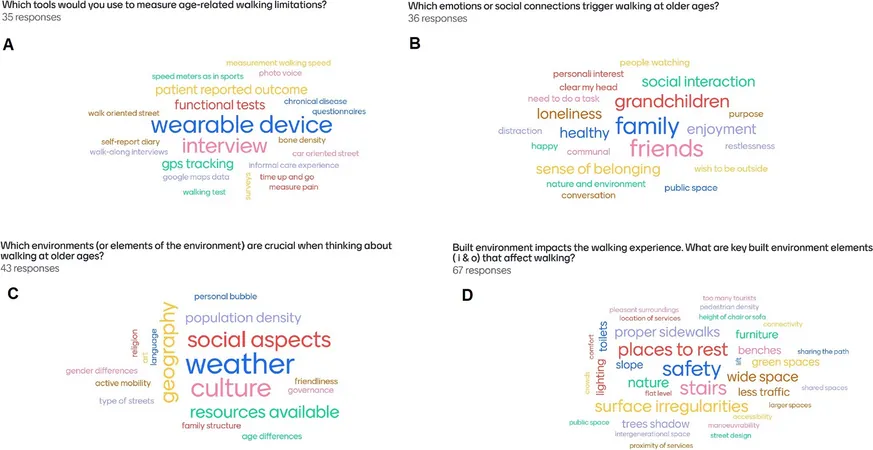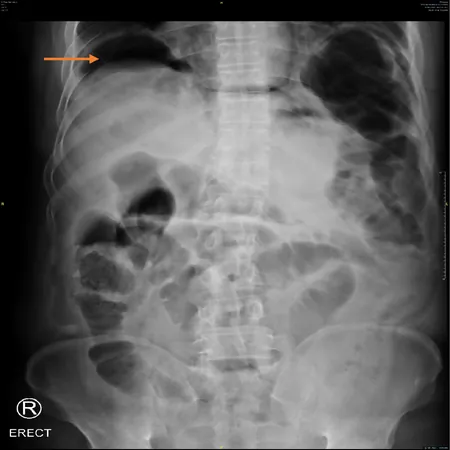
Towards a Walkable Future: Breakthrough Insights from Barcelona's Aging Workshop
2025-01-17
Author: Sarah
Towards a Walkable Future: Breakthrough Insights from Barcelona's Aging Workshop
A spotlight on the future of mobility for aging populations took center stage in Barcelona, where an insightful two-day workshop, titled “Aging towards Walkable Futures,” gathered 56 participants, with a significant gender diversity as 62% of them were women. Delegates ranged from young to senior citizens, with an average age of 40. The event, aimed at bridging disciplines, illuminated key discussions across four thematic sessions, each revealing critical insights into how walking impacts older adults.
Session 1: Understanding Walking as a Physical Experience
Before the workshop commenced, surveys indicated a deep concern regarding older adults' mobility, with 11.5% believing that many do not walk enough due to physical incapacity. However, a noteworthy 46.2% disagreed with the idea that walking impairments are uniform across different demographics.
The workshop revealed that walking is not merely a physical activity; it is a holistic experience that involves numerous physiological systems. As individuals age, walking efficiency declines. Reductions in physical activity lead to slower walking speeds and greater reliance on caregivers and assistive devices. Technologies—especially digital sensors—can offer compelling insights into walking characteristics, efficiently bridging lab studies with real-world applications. Parameters such as walking speed, daily step count, and cadence also provide critical information for assessing health and predicting functional decline.
Furthermore, insights stressed the necessity of looking beyond physical abnormalities. Healthcare professionals often treat mobility as merely a physical threshold, overlooking individual preferences and emotional needs. Successful evaluation must incorporate a multifaceted perspective, taking into account the unique preferences and lifestyle aspirations of older adults.
Session 2: The Emotional and Social Dimensions of Walking
Eighty percent of participants acknowledged that older adults often do not engage in sufficient physical activity due to emotional and social barriers—yet only a small fraction deemed these barriers irreversible. Discussions highlighted the vital role of solid social networks and implementations of supportive walking initiatives.
Engaging walking interventions should encompass social support structures and address feelings of loneliness, which are notably higher among older populations. Successful programs must hinge on community involvement, creating opportunities for social interaction through walking groups. For instance, the Federació d’Associacions de la Gent Gran de Catalunya (FATEC) exemplifies how local organizations can positively influence older adults' lives through active community participation.
Session 3: Creating Walkable Environments for Older Adults
An overwhelming 80.8% of participants voiced that inadequate environments—whether at home or in urban locales—restrict older adults' mobility. Distinct life-spaces, such as homes, neighborhoods, and broader city infrastructure, play an integral role in their walking experiences.
The workshop underscored how effective walkable environments can significantly enhance community engagement and physical activity levels among older adults. With insights from cities known for their walkability, it became clear that infrastructure—like handrails, safe pedestrian paths, and green spaces—influences mobility. Policies and interventions encouraging age-friendly urban planning are paramount, as exemplified by Barcelona's “Activa’t als parcs” program, which promotes physical activity in parks and has positively impacted over 1,700 older adults.
Session 4: Defining the Future of Walking for Older Adults
The final session encapsulated a collective realization of walking's multifaceted nature, encompassing physical, emotional, and social dimensions. A more holistic approach to mobility assessment and interventions is desperately needed. Not only must mobility be measured objectively, but personal satisfaction, expectations, and social engagement must also be evaluated.
Moreover, there is a critical need to close the gap between academic research and practical implementation. Collaborative efforts among researchers, urban planners, and community leaders are vital in transforming aged care methods into practical, supportive environments that promote active lifestyles.
As societies globally grapple with aging populations, these insights from Barcelona provide a pathway to fostering healthier, more inclusive, and walkable environments for older adults. The ongoing dialogue in this domain is essential—not merely for enhancing the dignity of aging, but for enriching the lives of older adults everywhere.



 Brasil (PT)
Brasil (PT)
 Canada (EN)
Canada (EN)
 Chile (ES)
Chile (ES)
 Česko (CS)
Česko (CS)
 대한민국 (KO)
대한민국 (KO)
 España (ES)
España (ES)
 France (FR)
France (FR)
 Hong Kong (EN)
Hong Kong (EN)
 Italia (IT)
Italia (IT)
 日本 (JA)
日本 (JA)
 Magyarország (HU)
Magyarország (HU)
 Norge (NO)
Norge (NO)
 Polska (PL)
Polska (PL)
 Schweiz (DE)
Schweiz (DE)
 Singapore (EN)
Singapore (EN)
 Sverige (SV)
Sverige (SV)
 Suomi (FI)
Suomi (FI)
 Türkiye (TR)
Türkiye (TR)
 الإمارات العربية المتحدة (AR)
الإمارات العربية المتحدة (AR)